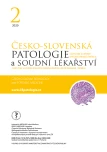How to improve the histopathological diagnosis of systemic vasculitides in daily practice?
Authors:
Eva Honsová
Authors‘ workplace:
AeskuLab Patologie, Praha
Published in:
Čes.-slov. Patol., 56, 2020, No. 2, p. 68-73
Category:
Reviews Article
Overview
The most common group of systemic vasculitides in adulthood are anti-neutrophil cytoplasmic antibody (ANCA)-associated vasculitis (AAV). AAV represent autoimmune systemic vasculitides and include 3 clinical phenotypes: Granulomatosis with polyangiitis (GPA, formerly Wegener granulomatosis), Microscopic polyangiitis (MPA) and Eosinophilic granulomatosis with polyangiitis (EGPA, formerly Churg-Strauss syndrome).
Histological features are similar to each other in all affected locations, and there are represented by necrotizing vascular inflammation of small and medium calibers, often venules, capillaries or arteriols, typically with fibrinoid vessel wall necrosis. The consequences of this condition are bleeding, as well as compromise of the lumen which may result in downstream tissue ischemia and necrosis. Typically affected locations in biopsy practice are: ENT, lung, skin, GIT, and kidney. The aim of this review is to provide a comprehensive overview of the important histopathological findings.
ANCA positive vasculitis is a serious life-threatening disease and therefore requires a rapid diagnosis and appropriate therapy.
Keywords:
histopathology – GPA – MPA – ANCA positive vasculitis
Sources
1. Jennette JC, Xiao H, Falk RJ. Pathogenesis of vascular inflammation by anti-neutrophil cytoplasmatic antibodies. J Am Soc Nephrol 2006; 17: 1235-1242.
2. Xiao H, Heeringa P, Hu P et al. Antineutrophil cytoplasmatic antibodies specific for myeloperoxidase cause glomerulonephritis and vasculitis in mice. J Clin Invest 2002; 110: 955-963.
3. Schlieben DJ, Korbet SM, Kimura RE et al. Pulmonary-renal syndrome in a newborn with placental transmission of ANCAs. Am J Kidney Dis 2005; 45: 758-761.
4. Roth A, Ooi JD, Hess JJ at al. Epitope specificity determines pathogenicity and detectability in ANCA-associated vasculitis. J Clin Invest. 2013; 123: 1773-1783.
5. Xie G, Roshandel D, Sherva R, et al. Association of granulomatosis with polyangiitis (Wegener’s) with HLA-DPB1*04 and SEMA6A gene variants: evidence from genome-wide analysis. Arthritis and rheumatism 2013; 65: 2457-2468.
6. Lyons PA, Rayner TF, Trivedi S et al. Genetically distinct subsets within ANCA-associated vasculitis. N Engl J Med 2012; 367: 214–223.
7. Watts RA, Scott DG. ANCA vasculitis over the world. What do we learn from country differences? Presse Med 2013; 42: 591-593.
8. Berti A, Warner R, Johnson K et al. Brief report: Circulating cytokiny profiles and antineutrophil cytoplasmatic antibody specificity in patients with antineurophil cytoplasmatic antibody-associated vasculitis. Arthritis Rheumatol 2018; 70: 1114-1121.
9. Unizony S, Villareal M, Miloslavsky EM et al. Clinical outcomes of treatment of anti-neutrophil cytoplasmatic antibody (ANCA) associated vasculitis based on ANCA type. Ann Rheum Dis 2016; 75: 1166-1169.
10. Jennette JC, Falk RJ, Bacon PA et al. 2012 Revised International Chapel Hill Consensus Conference Nomenclature of Vasculitides. Arthritis and rheumatism 2013; 65: 1-11.
11. Sunderkötter CH, Zelger B, Chen KR, et al. Nomenclature of Cutaneous Vasculitis: Dermatologic Addendum to the 2012 Revised International Chapel Hill Consensus Conference Nomenclature of Vasculitides. Arthritis Rheumatol 2018; 70: 171-184.
Labels
Anatomical pathology Forensic medical examiner ToxicologyArticle was published in
Czecho-Slovak Pathology

2020 Issue 2
Most read in this issue
- Primary vasculitides – current diagnostics and therapy
- Secondary vasculitis – omitted manifestation of many diseases
- Dermatofibrosarcoma protuberans with fibrosarcomatous transformation: a case report
- Pathophysiology of ANCA-associated vasculitis
